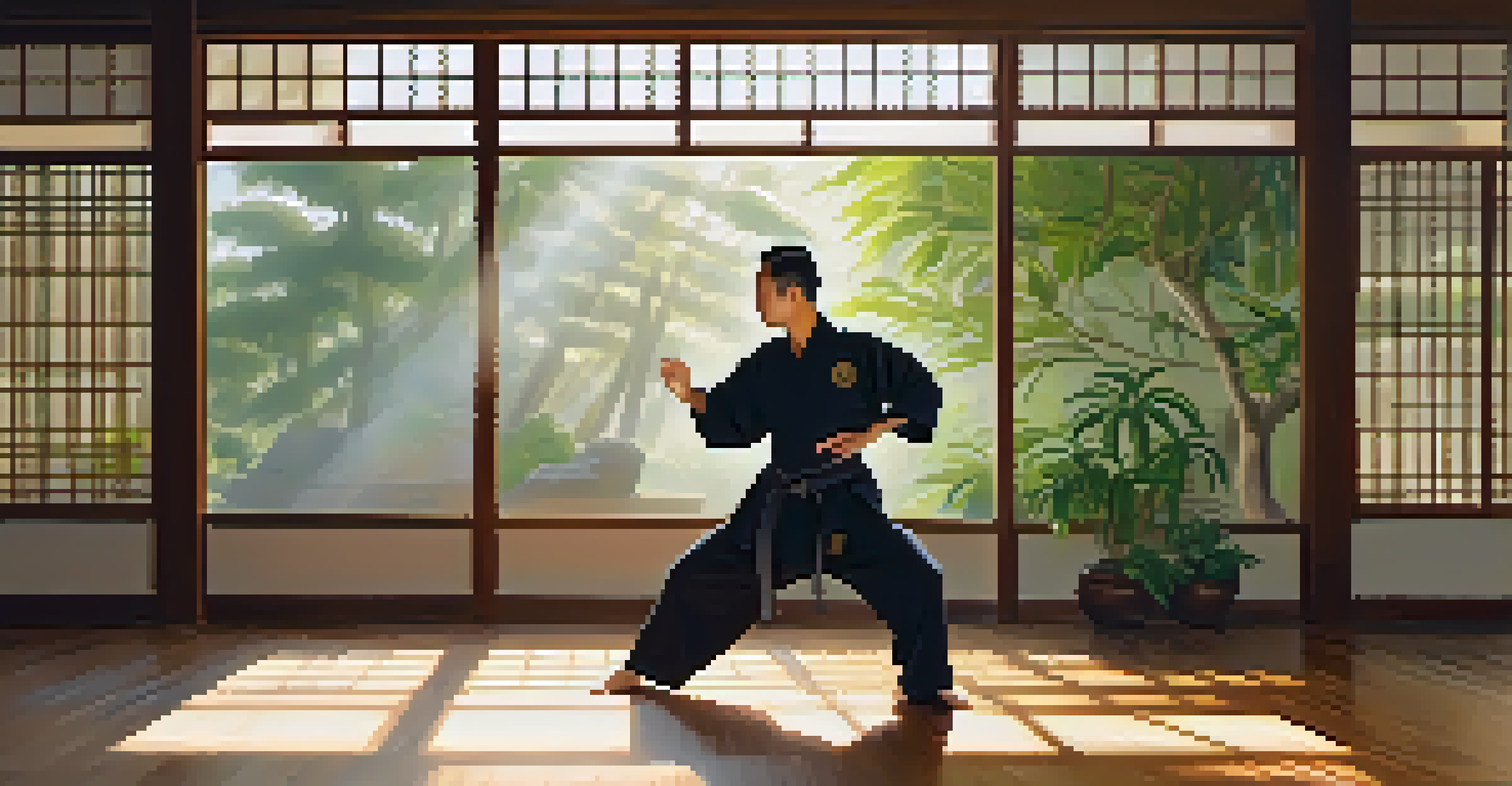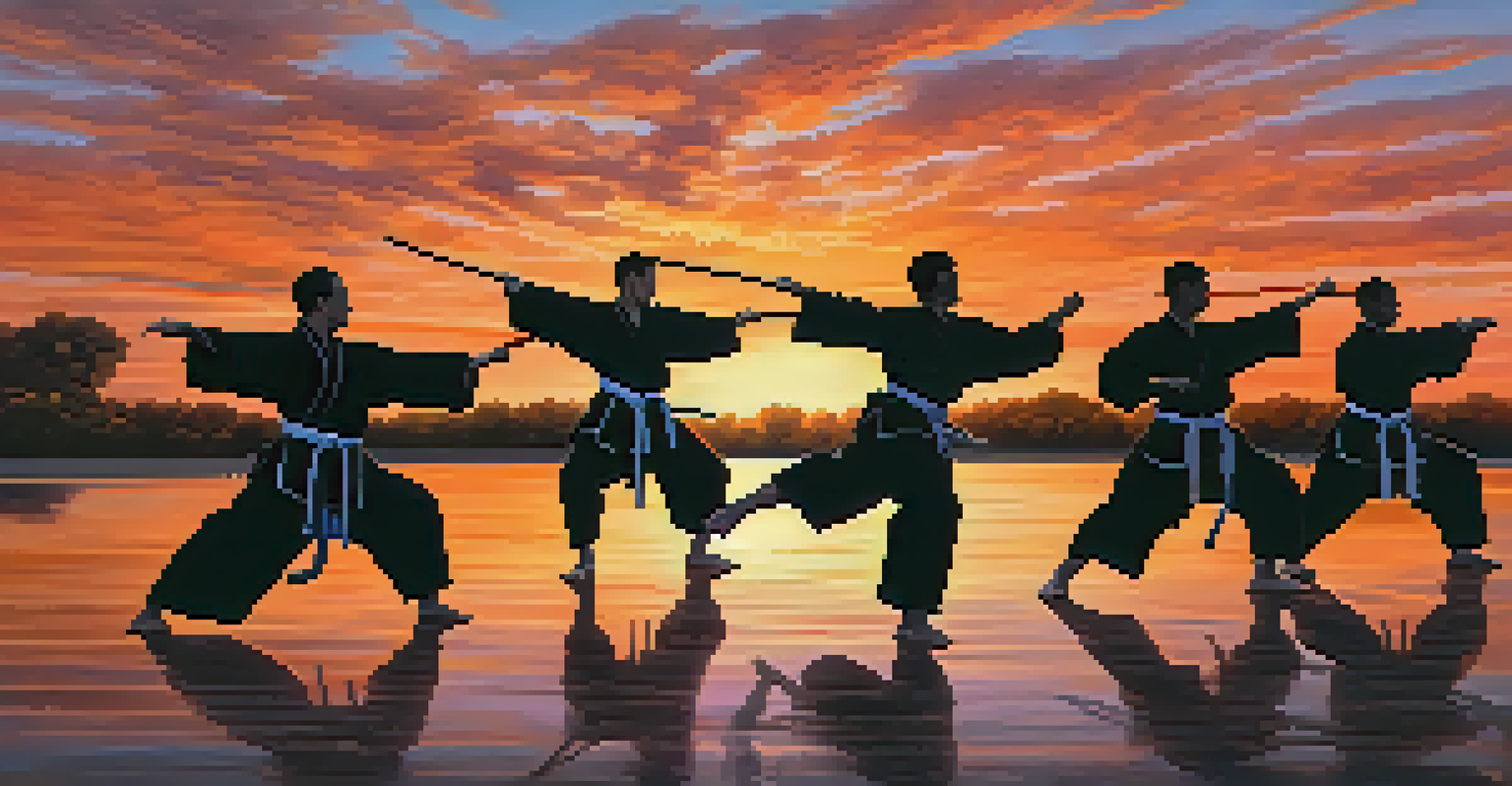The Role of Breath in Martial Arts and Movement Philosophy

Understanding Breath as Life Force in Martial Arts
In martial arts, breath is often regarded as the life force, or 'Qi' in Chinese philosophy. This concept emphasizes that the quality of our breath directly impacts our physical and mental performance. Just like a car needs fuel to run efficiently, our bodies need proper breathing techniques to harness energy effectively.
Breath is the bridge which connects life to consciousness, which unites your body to your thoughts.
When practitioners learn to control their breath, they can enhance their focus and stamina. For instance, deep breathing can help calm the mind before a match, allowing fighters to think clearly and react swiftly. This connection between breath and focus is why many martial traditions incorporate breath control into their training regimens.
Moreover, understanding breath is essential for injury prevention. By maintaining proper breathing patterns, martial artists can reduce tension in their bodies, promoting greater flexibility and balance. This holistic approach ensures that breath is not just an afterthought but a core component of a martial artist's practice.
Breath Control Techniques in Martial Arts Training
Various martial arts employ specific breath control techniques that practitioners must master. For instance, in Tai Chi, slow and deep breathing is synchronized with movement, creating a meditative state that enhances concentration. This integration of breath and movement is a cornerstone of many Eastern martial arts.

Karate, on the other hand, often utilizes 'Kiai,' a spirited shout combined with a powerful exhale. This technique not only focuses energy for maximum impact but also serves as a way to intimidate opponents. It’s a fascinating blend of physicality and mental fortitude, showing how breath can amplify strength.
Breath: Key to Martial Arts Mastery
Mastering breath control enhances focus, stamina, and overall performance in martial arts.
Practicing these techniques regularly helps develop a deeper awareness of one's body and mind. As martial artists refine their breath control, they also cultivate patience and discipline—qualities that extend beyond the dojo into everyday life.
The Psychological Impact of Breath in Combat Situations
In high-pressure situations, such as competitions or self-defense encounters, breath control can significantly affect performance. When stress levels rise, our breathing often becomes shallow and rapid, which can lead to panic and poor decision-making. This is where practiced breathing techniques come into play.
The breath is an anchor to the present moment, the only place we can truly live.
Martial artists learn to recognize these physiological responses and to counteract them by returning to steady, deep breathing. This practice not only calms the mind but also helps maintain a clear focus on the task at hand. It's much like a musician tuning their instrument before a concert—finding that rhythm is crucial for success.
Furthermore, mastering breath can instill confidence. Knowing that they have a tool to regain composure allows martial artists to face challenges head-on. In this way, breath becomes not only a physical tool but also a psychological ally.
Breath and Movement Philosophy: A Holistic Approach
Movement philosophy often intertwines with breath, highlighting the importance of being fully present in each action. Many movement practices, from yoga to dance, emphasize the synchronization of breath and movement to enhance flow and efficiency. This principle is equally applicable in martial arts.
When movements are executed with conscious breathing, they become more fluid and graceful. Picture a dancer flowing seamlessly across the stage—every breath is a part of the choreography. Similarly, martial artists can achieve a sense of harmony in their techniques when breath is integrated into their movements.
Mindfulness Through Breath Awareness
Focusing on breath cultivates mindfulness, transforming movements into intentional and powerful expressions.
Ultimately, this holistic approach promotes a deeper connection between the body and mind. By making breath a focal point, practitioners can experience movement not just as a series of actions, but as a form of expression and mindfulness.
Breath in Recovery: Importance After Training
After intense training or combat, breath plays a crucial role in recovery. Proper breathing techniques can help lower heart rates and reduce muscle tension, facilitating a quicker return to a resting state. This is similar to how athletes cool down after a workout to help their bodies recover.
Many martial artists practice specific breathing exercises post-training, allowing the body to relax and rejuvenate. Techniques such as diaphragmatic breathing can enhance oxygen flow to the muscles, aiding in recovery and reducing soreness. This practice not only benefits physical health but also mental clarity.
Incorporating breath into recovery routines also reinforces the importance of self-care. By taking the time to breathe deeply and mindfully, practitioners are reminded that recovery is as vital as training itself—a lesson that can enhance longevity in any physical discipline.
Breath as a Tool for Mindfulness in Movement
Mindfulness is about being present in the moment, and breath serves as an anchor for this practice in martial arts. By focusing on the rhythm of their breath, practitioners can ground themselves, making each movement intentional and aware. This shift from autopilot to conscious action transforms the way they engage with their art.
An example of this is found in the practice of meditation, where the breath becomes a focal point to quiet the mind. Martial artists can adopt similar techniques during training, allowing them to center their thoughts and enhance their performance. This creates a powerful feedback loop where improved focus leads to better execution.
Cultural Depth of Breath Practices
Understanding the cultural significance of breath connects martial artists to their heritage and the broader community.
Moreover, this mindfulness extends beyond the dojo. Practitioners often find that the skills developed through breath awareness can be applied to daily life, helping them navigate stress and challenges with greater ease. In essence, breath becomes a bridge between martial arts and living fully in each moment.
The Cultural Significance of Breath in Martial Arts
In many cultures, breath holds significant spiritual and philosophical meaning, especially in martial arts. Practices such as Qigong and yoga emphasize breath as a channel for energy flow, connecting practitioners to their inner selves and the universe. This cultural lens enriches the understanding of breath beyond mere physicality.
For instance, in Japanese martial arts, the concept of 'Kokyu' refers to the rhythm and depth of breath, which is essential for cultivating a strong spirit. This understanding reflects a broader worldview where breath is seen as a vital force that transcends the individual, linking them to their community and environment.

By appreciating the cultural significance of breath, martial artists can deepen their practice and connect with traditions that have shaped their art. This connection not only honors their heritage but also fosters a sense of belonging within the global martial arts community.